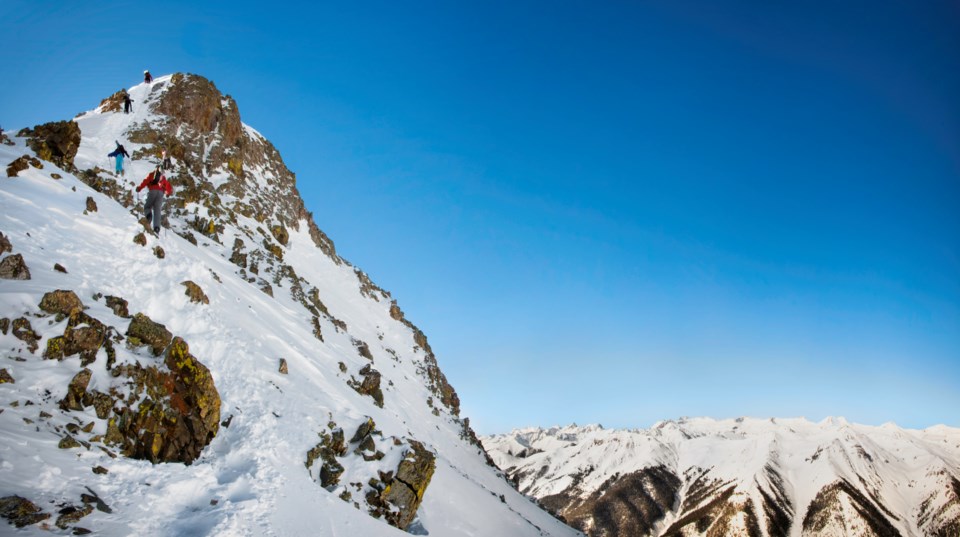On July 10, Bluebird Backcountry—the lift-free, human-powered ski area situated on Bear Mountain, Colo.—announced the operation’s permanent closure after running out of funding and failed attempts to secure a long-term investor.
Bluebird first opened as a Kickstarter-funded pilot project in 2019, and operated on private land with minimal infrastructure of tents and yurts for its base area. A variety of no-frills accommodation was available, from car camping to cabins and on-hill “domes.” Bluebird had a total of more than 1,700 hectares (4,200 acres) of skiable terrain, with 485 ha (1,200 acres) of that area avalanche-controlled and ski-patrolled. The peak elevation of Bear Mountain is 3,000 metres (9,845 feet) with a skiable vertical of 379 m (1,245 ft). From the photos and maps I looked at, the entire area is treeline with a handful of double-black runs.
Skiers would pay US$50 for a ticket to access the terrain and another $50 for two-hour backcountry lessons from guides and instructors. Backcountry gear rentals and intro safety clinics were readily available, with an emphasis on education and letting aspiring ski-tourers learn with confidence. Perhaps most attractive of all, everyone could bring their dogs.
Co-founders Jeff Woodward and Erik Lambert were motivated by what they saw as a growing market of entry-level backcountry enthusiasts. People were tired of both the congested traffic on Colorado’s infamous I-70 highway and also tired of the infamous lift lines that plague Colorado’s “front range” ski areas.
And for the most part, Woodward and Lambert were right. Bluebird was popular, and it opened at a time when pandemic demand for outdoor recreation was at its peak, with ski touring as one of the fastest-growing niches. Visits climbed every season and the accommodations were booked up every winter weekend. The Colorado Sun reported that sales climbed 22 per cent and visits were up 36 per cent in 2022-23 compared to the 2021-22 season.
So why did Bluebird fail? The first reason is an age-old recipe for the economic failure of ski areas: location. The three-hour drive from metropolitan Denver—which accounted for approximately 60 per cent of Bluebird’s business—was a strong deterrent for repeat visits despite the affordable options for multi-day stays.
The second reason is just as familiar, and applies to any business: you have to spend money to make money. For Bluebird, the money dried up before the operation could turn profitable. High interest rates, fears of a recession, and general economic belt-tightening meant investors were less likely to back startups.
I was personally over the moon when Bluebird opened. It was the next logical step after a hybrid model like Silverton Mountain (also in Colorado), which offers backcountry skiing via a single lift, then hiking or touring into neighbouring bowls and chutes. But the comparison of the two is one of apples and oranges. Silverton also has a heli operation and a lot more expert terrain adding to its attraction for destination visitors. Bluebird was moreso helping to fill the ever-widening gap between beginner backcountry skiers and experienced and knowledgeable backcountry skiers with a safe environment in which to learn.
“The backcountry segment is growing rapidly, despite all the barriers to entry,” Lambert told the Sun in 2019, the summer before Bluebird opened. “We hope that we can revolutionize education by filling those gaps, and revolutionize the culture of skiing here in Colorado by giving people more options.”
The closest we have to Bluebird’s model here in B.C. is the Hankin-Evelyn Backcountry Recreation area, located 45 minutes from Smithers. Hankin-Evelyn is more or less volunteer-run (with little in the way of commercial interest), and is the perfect place to learn how to ski tour.
The saddest thing about Bluebird’s closure is that it has set a precedent in the ski industry that will make other entrepreneurs think twice about attempting the same model of human-powered ski areas in their own regions. Mega-resort consolidations will continue to erode the alpine ski resort experience with cost-cutting measures. The option of heading straight to the backcountry is becoming more and more of a stress for search-and-rescue organizations.
I’ve brought up the Hankin-Evelyn model before as a possible concept in the Sea to Sky to attract beginner ski-tourers and give them a safer place to learn, rather than cutting suicide skin tracks across the open avalanche slopes in the Musical Bumps. Operations like Bluebird prided themselves on fostering mentorship among up-and-coming ski tourers, which is severely lacking in our own ski-touring community. Volunteer organizations like Mountain Mentors do a great job of getting young women safely initiated into mountain environments, but the demand far eclipses the number of new candidates they’re able to accept.
What other options exist to make ski touring safer and less cowboy in the Sea to Sky? I’m not sure yet. Let me get back to you in a future column.
Vince Shuley is trying not to think too much about winter right now. For questions, comments or suggestions for The Outsider, email [email protected] or Instagram @whis_vince




